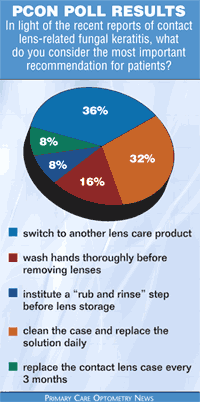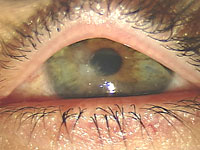Polymer combination at root of Fusarium outbreaks, physicians say
Click Here to Manage Email Alerts
SINGAPORE – A combination of polymers that were added to a common contact lens solution to improve comfort may be a key part in the Fusarium keratitis outbreaks that occurred earlier this year, said Donald T. H. Tan, MBBS, FRCSG, FRCSE, FRCOphth, FAMS, here at the Asia-Pacific Academy of Ophthalmology meeting.
|
Image: University of Iowa |
Prof. Tan said the polymer film build-up in Bausch & Lomb’s ReNu contact lens solution “trapped” the Fusarium molecule that led to the significant number of outbreaks.
Prof. Tan and colleagues at the Singapore National Eye Center were the first to discover the outbreak of Fusarium and link it with contact lens solution.
“The disinfectant in [ReNu with] MoistureLoc is actually very effective,” Prof. Tan said. “The problem is when you add other things in, like the polymers to improve comfort. The polymers are actually trapping the fungus so that the disinfectant, which is very strong, cannot get at the fungus.”
In an interview with Primary Care Optometry News sister publication, Ocular Surgery News, Prof. Tan said, “Bausch & Lomb has clearly shown a plausible sequence of events in which MoistureLoc would be more likely to cause this outbreak than other solutions.”
This sequence of events is related to poor compliance by contact lens wearers combined with the polymer issue. Prof. Tan said Bausch & Lomb has found that the fungus can grow on the tip of an open bottle or on the cap if the bottle is not closed, because it is “trapped” there by the polymers.
He added B&L found the practice of “topping off” that is common among contact lens wearers seems to have led to the cases of Fusarium. Topping off is when a contact lens wearer does not rinse the used solution from the lens case before refilling it with fresh solution, Prof. Tan explained.
He presented data on behalf of Bausch & Lomb during an APAO-sponsored symposium, indicating that the combination of polymers in the ReNu with MoistureLoc solution builds up when the water in the solution evaporates. Fusarium can survive in the leftover build-up and attach to the contact lens when it is washed out in the solution, Prof. Tan said. If the wearer topped off the solution instead of cleaning out the contact lens case, the disinfectant in MoistureLoc “cannot break through the film and kill the bacteria,” thereby allowing it to reach the corneal surface, Prof. Tan said.

Executives with Bausch & Lomb agreed, telling Ocular Surgery News that the formulation issue is “a result of noncompliant behaviors relating to evaporative conditions favoring polymer concentration, such as topping off, not changing solution daily and not cleaning and replacing the lens case.”
Bausch & Lomb referred to this as a “causal relationship” between film build-up and noncompliant habits.
The polymer theory is part of a problem also related to the type of disinfectant molecule specifically used in MoistureLoc, Terrence O’Brien, MD, said. B&L opted to use alexidine, a smaller molecule than the company previously used, in the MoistureLoc formulation, Dr. O’Brien said. The smaller weight meant that absorption into the lens material is prohibited, but that also means the Fusarium bacteria can survive on the surface of the contact lens, he said.
“We don’t just need disinfectants in these solutions, we need biocompatible disinfectants,” he said.
Dr. O’Brien said case control studies are underway at Bascom Palmer Eye Institute in Miami and in sites in Singapore and Malaysia.
To date, Prof. Tan has found 68 cases of Fusarium keratitis in Singapore, and Dr. O’Brien has reported 130 confirmed cases around the United States. An additional 18 cases have been found in Malaysia at one physician’s practice, they said.
“I think we still need to clear up issues,” Prof. Tan said. “It is still surprising why there was MoistureLoc use in other countries, which did not have any infections at all, such as throughout Europe. There are still these unanswered questions. We also saw Fusarium keratitis in other contact lens solutions. This could just be ‘noise,’ but I think it’s time to also have a look at how solutions are tested and review the current guidelines.
For more information:
- Donald T. H. Tan, MBBS, FRCSG, FRCSE, FRCOphth, FAMS, can be reached at Singapore National Eye Center, 11 Third Hospital Ave., Singapore 198751; 65-6227-7255; fax: 65-6323-1903; e-mail: snecdt@pacific.net.sg.
- Terrence P. O’Brien MD, can be reached at Bascom Palmer Eye Institute, 7108 Fairway Dr., Palm Beach Gardens, FL 33418; (561) 515-1544; fax: (561) 515-1588; e-mail: tobrien@med.miami.edu

